| |
|
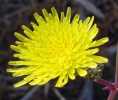 | |
| MaltaWildPlants.com by Stephen Mifsud |

|
| |
|
|
 |  |  |  |
| External Links: |
|
Diplotaxis tenuifolia (Perennial Wall Rocket) |
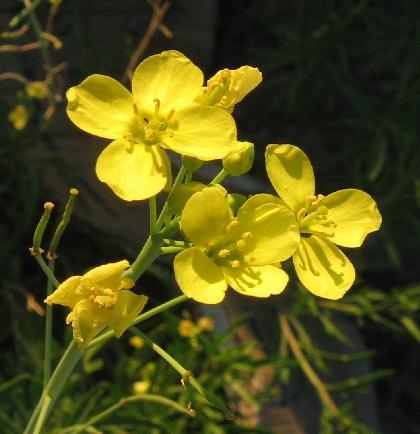
Diplotaxis tenuifolia (BRASSICACEAE.)
Images for this profile are taken from the Maltese Islands after year 2000. |
|
| Nomenclature |
Species name : | Diplotaxis tenuifolia (L.) DC. | Authority : | Carl von Linne, Sweden, (1707 - 1778) ;
Augustin Pyramus de Candolle, Switzerland, (1778 - 1841) | Synonyms :
(basionym or principal syn.) |
|
Plant Family : | Brassicaceae Juss. (= Cruciferae )
(Mustard or Cress Family) | English name(s) : | Perennial Wall Rocket, Sand Rocket, Slim-leaved Wall Rocket | Maltese name(s) : | Ġarġir isfar | Status for Malta : | Indigenous. Present on the Maltese islands before man | Name Derivation : |
Diplotaxis: Arranged in two ranks or rows, with reference to the placement of seeds in the fruit pod. (Greek origin ); 2 = ? unknown.
tenuifolia: Slender or narrow leaves. ( ); 2 = Slender leaves (Latin).
| Remarks : | |
|
| Morphology and structure |
PLANT STRUCTURE: |
Character | Growth Form | Branching | Surface |
Description | | | |
General
Picture |  | 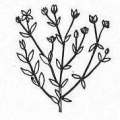 |  |
|
LEAVES: |
Character | Arrangement | Attachment | Venation |
Description | | | |
General
Picture |  | 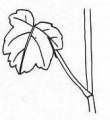 |  |
| |
Character | Leaf Shape | Leaf Margin | Remarks |
Description | | | Odour The leaves gives off a charateristic mild unpleasant smell. This is however a subjective observation as some eat it as salad. |
General
Picture |  |  |  |
|
FLOWERS: |
Character | Colour | Basic Flower Type | No. of Petals | No. of Sepals |
Description | Bright Yellow | | 4 | 4 |
General
Picture | | 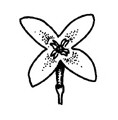 |  |  |
| |
Character | Inflorescence | Description | Ovary | Stamens |
Description | | The flower consists of 4 oval, non-overlapping yellow petals arranged diagonally to each other, 6 stamens and a central pistil with swollen stigma. | | |
General
Picture |  |  | 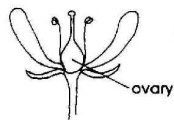 | 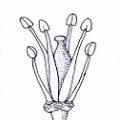 |
| |
Character | Scent | Average Flower Size | Pollen Colour | Other Notes |
Description | None The flowers do not have a particular scent or a very faint one. | 16-18mm | Yellow | - |
|
SEEDS: |
Character | No. Per Fruit | Shape | Size | Colour |
Description | 32-60 | Globular to ovoid Spherical to oval shape with a small indentation. | 1-2mm | Reddish brown to Dark Brown |
General
Picture |  |  |  |  |
|
FRUIT AND OTHER BOTANICAL DATA: |
Character | Fruit Type | Colour of Fruit | Subterranean Parts | Other Notes |
Description | | Pale Green Turns light brown when fully ripe. | | - |
General
Picture | 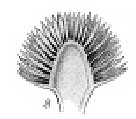 |  |  |  |
|
|
| Plant description and characters | |
Life Cycle: | Perennial. |
Growth Form: | HEMICRYPTOPHYTE (prostate plants with flowers close to the ground) |
Habitat: | Fields, waysides, wasteland, piles of stones, besides or through walls |
Frequency: | Very Common |
Localities in Malta: | Very Common throughout the Maltese Islands mostly in stony wasteland and waysides. |
Plant Height: | 40-100cm. |
| Oct-Jun |
Protection in Malta: | Not legally protected till the last update of this website (2/Mar/2022) |
Red List 1989: | Not listed in the Red Data Book of the Maltese Islands |
Poison: | |
Diplotaxis tenuifolia is a perennial plant which almost flowers all year round, but it is mostly noticible in late September and October where there are very little flowers in the wild after the arid Summer. The stem is woody at its base, glabrous, forms branches with a dense numbers of leaves and with apical raceme inflorescences. The leaves are bluish to dark green mostly deep pinnate, fleshy, short stalked, and slender. Blade shape varies a lot from plant to plant. Usually there is 1 or 2 pairs of slender, long leaf lobes along the length of the narrow leaf blade. Upper cauline leaves are more lanceolate/linear and unlobed. All leaves are glabrous and usually have an entire outline, or possess small undeveloped leaf lobes (as if outline is serrated).
Flowers are sulphur yellow, normally 15-18mm across and are attached to the stem by a relatively long peduncle (2 - 3 times the length of the flower). The flowers are hermaphrodite (have both male and female organs) and are pollinated by insects. Flowers are made up of 4 sepals, 4 petals that are arranged diagonally forming the shape of a cross, 6 tetradynamous stamens,that is 4 central and long, 2 adjacent and shorter, and a central green pistil with an inflated pale green style.
Fruit are in the form of erect rod-shaped siliqua (25-35mm long x 2 mm across) which are slightly bulging with the seeds inside. The fruit pods have a short apical beak and are separated from the stalks by a distinct constriction. The fruit walls split open with a sudden twist and hence spread the seeds to a further distance away leaving a central translucent partition (called replum) along the length of the siliqua. The seeds are arranged in paired rows and attached at each side of the replum by tiny stalks called funiculi. There can be up to 60 seeds per fruit. They are spherical to ovoid in shape and brown to light brown in colour.
|
|
| Information, uses and other details |
General Info
Plant with an unpleasant scent, but flowers are slightly sweet scented. This plant and the stinkweed are the only yellow-flowered Cruciferae to have an unpleasant smell when crushed. [275]
Edible Uses:
Leaves - raw. Used in salads, they are very strongly flavoured of cress [217]. The leaves have a hot flavour, very similar to rocket (Eruca vesicaria sativa) but more strongly flavoured - they make an excellent addition to a mixed salad but are too strong to be used in quantity on their own. The plant is very productive, producing leaves from early spring until the autumn. [KF]
Personal observations:
Dispersion
Dispersion of seeds is by sudden outwards twisting of the 2 outer walls (valves) forming the siliqua [SM]
Flowering season
One cannot really say the normal flowering period of this plant in Malta. There are flowers of the Diplotaxis tenuifolia in almost in all months of the year. Apparently, the seeds germinate into the plant soon after it rains, irrelevant of the temperature and season. In the middle of Summer there are less numbers but then after the showers in September, the plant regenarates and produces many flowers that blossom at the end of September or later in October. The plant rapidly grows and flowers up from the roots of older plants when water is available. Their flowers are readily noticed in October and November, because not many other flowers are in blossom at these months. They are independent plants, and rarely form carpets of yellow flowers.
Comparison with Brassica rapa subsp silvestris
In Malta there is another Cruciferae plant which is very similar to the Perennial wall rocket but it is less abundant and usually does not grow beside or from walls. This plant is called the Wild turnip (Brassica rapa ssp. silvestris) The perennial wall rocket can be easily mistaken for the Wild Turnip at first glance because the yellow flowers and slender fruit pods are very similar. The main differences are the leaves, size of plant, size of flower and sepals as indicated in the table below: [SM]
| Feature |
Brassica rapa spp silvestris |
Diplotaxis tenuifolia |
| Leaves |
Large, ovoid, serrated, hairy and the young leaves have base lobes whic embrace stem |
Smaller, deeply dented, elongated, smooth, no embracing lobes |
| Sepals |
Few mm below flower, long, perpendicular to stem |
Small, cup shaped near to flower |
| Plant Size |
40cm average |
60-80cm average |
| Flower Size |
13mm average |
slightly larger, 15mm average |
| Apical beak of seed pod |
Long |
Very short |
Not much information has been found about this particular plant species. If you can supply further info to be included in this profile, please do not hesitate to email us pr by using the form found at the botom of this page. Full reference credits will be given accordingly. Thank you for your support!
|
|
| Links & Further literature
(0 papers) |

Google Web |

Google Images |

Google Scholar |

Research Gate |

Wikipedia |

JSTOR |

GBIF |

Med Checklist |

Cat. of Life |

EoL |

IPNI |

World Flora Online |

Plants of the World Online |

Vienna Virt. Herb. |

RBGE Herbarium |

KEW Herbarium |

MNHN |

Arkive |

IUCN |

CABI |
Kindly Email if there are papers and publications about local
studies or information about this species to be included in the list above.
|
| Photo Gallery (35 Images) | 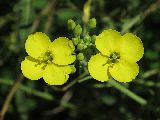 |
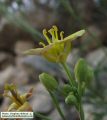 |
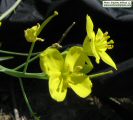 |
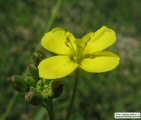 |
IMAGE: DTXTF-01 Photo of yellow flower with 4 petals perpendicular to each other forming the shape of a cross. |
IMAGE: DTXTF-02 Photo (lateral view) of the flower showing the arrangement of the sepals, style with a green swollen stigma, and arrangement of the 6 stamens - 2 short and lateral; 4 central and longer. Sepals are not horizontally spread-out. |
IMAGE: DTXTF-03 Photo of two flowers consisting of 4 bright yellow petals, 6 stamens and a central pistil with a pale green swollen stigma. |
IMAGE: DTXTF-04 Close up photo of a flower in situ. |
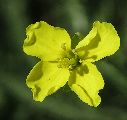 |
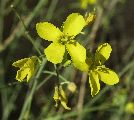 |
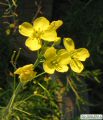 |
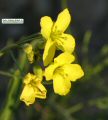 |
IMAGE: DTXTF-05 Photo of young flowers with four rounded petals marginally overlapping each other. |
IMAGE: DTXTF-06 Photo of mature flowers with petals getting more spaced apart. |
IMAGE: DTXTF-07 Close up photo of flowers showing in detail the stamens and their yellow anthers and also the central style and its swollen stigma. |
IMAGE: DTXTF-08 Close up photo of stalked flowers in the raceme, the type of inflorescence for this species and most members of this plant family (Brassicaceae or Cruciferae). |
 |
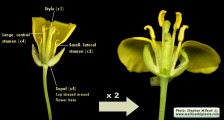 |
 |
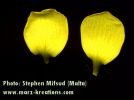 |
IMAGE: DTXTF-09 Scanned image of a flower against a dark background. Note the typical arrangement of the stamens, 4 central and long, 2 lateral and short. The pistil has a green style and a swollen stigma. |
IMAGE: DTXTF-10 Scanned and annotated image of a longitudinally dissected flower to show in detail the arrangement of the flower parts. |
IMAGE: DTXTF-11 Photo of the 4 pale green sepals below the petals. They are not overlapping and shorter from the petals. |
IMAGE: DTXTF-12 Scanned image of the nearly circular petals. |
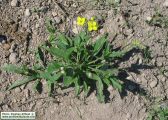 |
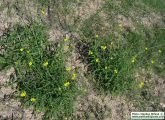 |
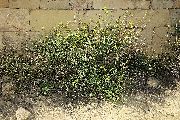 |
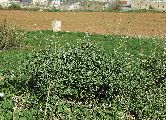 |
IMAGE: DTXTF-13 Photo of a young plant in situ (top view) with its numerous slender leaves. |
IMAGE: DTXTF-14 Photo of plant in situ with dark green leaves and numerous long racemes with clusters of bright yellow flowers at the top. |
IMAGE: DTXTF-15 Typical habitat of Diplotaxis tenuifolia - sides of roads or paths. |
IMAGE: DTXTF-16 Photo of plant in abandoned fields, another preferred habitat of the species. |
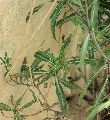 |
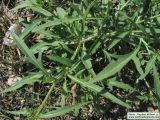 |
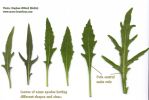 |
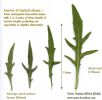 |
IMAGE: DTXTF-17 Photo of dark green, leathery leaves that are polymorphic: ranging in shape from from unlobed, narrow-lanceolate to multilobed. Lower leaves are usually of the latter type while upper stem leaves are of the former. |
IMAGE: DTXTF-18 Photo of the slender leaves with pairs of lateral lobes at their base. |
IMAGE: DTXTF-19 Scanned image of various leaf-forms of this species. It clearly shows the variation which exists in the shape of the leaves. |
IMAGE: DTXTF-20 Scanned image of 4 typical leaves of different maturity. Length of adult leaf blade is approximately 10-12cm. |
 |
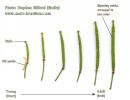 |
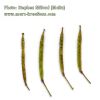 |
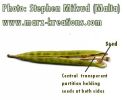 |
IMAGE: DTXTF-21 Scanned and enlarged image of a typical leaf blade. It is a slender linear to lanceolate leaf with one or two pairs of leaf lobes. |
IMAGE: DTXTF-22 Scanned and annotated image of several siliqua at increasing (left to right) maturity levels. |
IMAGE: DTXTF-23 Scanned image of 4 ripe fruit pods. Note the short apical beak and the slightly bulging pod with the seeds inside. |
IMAGE: DTXTF-24 Scanned image of a ripe siliqua, partially opened and liberating its seeds. Note the central internal partition to which seeds are attached to. |
 |
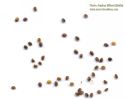 |
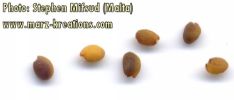 |
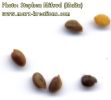 |
IMAGE: DTXTF-25 Scanned image of an empty fruit pod, where its fruit walls have dropped off and the seeds dispersed, hence leaving this characteristic translucent central partition. |
IMAGE: DTXTF-26 Scanned image of the seeds. About 40-60 per seed-pod. |
IMAGE: DTXTF-27 Scanned and enlarged image of the seeds. More or less oval in shape with a small indentation at one end. |
IMAGE: DTXTF-28 Scanned and enlarged image of the seeds. They can be light brown to dark brown in colour. |
 |
 |
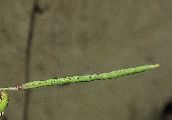 |
 |
IMAGE: DTXTF-29 Scanned image of a typical flowering stem having its inflorescence of a few flowers at the apex, followed by numerous seed pods (Siliqua) further down the stem. |
IMAGE: DTXTF-30 Photo of basal stems and taproot. They are very tough, wood-like and thick. Taproot starts few cm below from where the branching stems unite into one main stem. |
IMAGE: DTXTF-31 Close up photo of the seed pod (called siliqua) in situ. They are usually green, have a short beak and constrictions around their seeds packed inside. |
IMAGE: DTXTF-32 Photo of siliqua. Differs from pods of Fabaceae (peas and beans) in having a central longitudinal wall that divides the seeds inside the capsule into two partitions. |
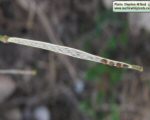 |
 |
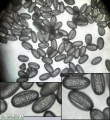 |
| IMAGE: DTXTF-33 Photo of a siliqua that has just split open leaving the translucent central partition and some seeds towards the tip, still attached to the seed pod by tiny stalk-like structures called funiculi. |
IMAGE: DTXTF-34 Photo of plant taken in November. Plants are found flowering almost all year round, especially in Autumn. |
IMAGE: DTXTF-35 Magnified image of pollen under light microscope. They have an oval shape, a pitted texture and longitudinal grooves. |
IMAGE: DTXTF-36 |
|
| | |

